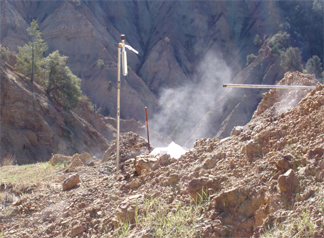 In August 2004,
a mysterious patch of hot soil triggered a forest fire in Southern California’s
Los Padres National Forest. A fire crew arrived on the scene and extinguished
the fire, which burned 3 acres of land in the rugged backcountry of the Dick
Smith Wilder-ness, but crews were baffled by a lingering heat emanating from
fissures in the ground.
In August 2004,
a mysterious patch of hot soil triggered a forest fire in Southern California’s
Los Padres National Forest. A fire crew arrived on the scene and extinguished
the fire, which burned 3 acres of land in the rugged backcountry of the Dick
Smith Wilder-ness, but crews were baffled by a lingering heat emanating from
fissures in the ground. Scientists used this tube to collect gas samples from unusual hot cracks in the ground in the Los Padres National Forest in California. Steam beyond the sampling site emanates from hot cracks along the cliff. The hotspot sparked a fire in the park in August 2004. Image courtesy of Robert Mariner.
Despite multiple research expeditions, scientists have been unable to determine the cause of the heat, though they have ruled out volcanic activity and nearby springs. Now, landslide debris and various faults remain the focus of study by Allen King, a U.S. Forest Service geologist, and colleagues, who hope to discover the phenomena responsible for triggering and sustaining the hotspot.
Fire crews initially measured the heat with a candy thermometer, which topped-out at the thermometer’s 400-degree-Fahrenheit (204-degree-Celsius) limit. “When I first heard about it [from King] and he said ‘candy thermometer,’ I of course kind of laughed,” says Robert Mariner, a U.S. Geological Survey hydrologist who studies gases and water associated with volcanoes.
More recently, equipped with an infrared remote heat sensor, King and colleagues flew by helicopter to the site and measured a maximum temperature of 584 degrees Fahrenheit (307 degrees Celsius) at a spot about 365 centimeters underground. Fifteen months after the fire, the site has only slightly cooled.
“These vents are appreciably above boiling point,” Mariner says. “You see these occasionally on volcanoes, but it’s very unusual to see them anywhere else.” According to King, the ratios of gases measured — carbon dioxide, methane, carbon monoxide and hydrocarbons — don’t support volcanic or geothermal spring activity as the source of heat.
Instead, the leading hypothesis, presented by King at the Geological Society of America annual meeting in Salt Lake City, Utah, in October, was that a 17-acre landslide in the forest in 1998 allowed a chemical reaction to occur. The event churned up Eocene marine shale deposited 56 to 34 million years ago, exposing its iron sulfides to oxygen. This exposure, King says, could have triggered a chemical reaction that allowed the organic materials within the shale to burn.
In the past, debris excavated from mines that contained similar iron sulfides have been known to combust, King says, but “our site is a natural phenomenon. Humans didn’t have anything to do with it as far as we can tell.”
A chemical reaction instigated by the nearby landslide remains the group’s “best hypothesis,” King says, but he is also looking into other possible heat sources, including the region’s numerous faults. A major fault exists just over 1 kilometer from the slide area, with smaller faults closer to the site. Combustible gases such as methane might have migrated from the faults to the hotspot in abundances that are not yet apparent at the site, King says.
Pockets of methane associated with the shale could also be a possible contribution, according to James Boles, a sedimentary petrologist at the University of California in Santa Barbara. The extra gas would provide the additional fuel needed to sustain the reaction.
But whether conditions for combustion arose from iron sulfides in the shale or some other source, researchers remain puzzled by what would have triggered the burning. “It’s not like somebody was there with a match,” Boles says.
The team hopes that future expeditions to take samples from greater depths, rather than just below the surface, will turn up answers. “We’re optimistic enough to keep trying,” King says.

